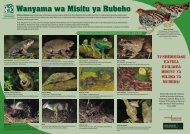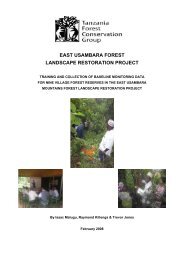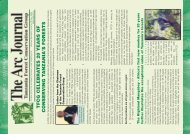Assessment of the biological values of different land cover types in ...
Assessment of the biological values of different land cover types in ...
Assessment of the biological values of different land cover types in ...
Create successful ePaper yourself
Turn your PDF publications into a flip-book with our unique Google optimized e-Paper software.
1) Introduction<br />
1.1 Background to <strong>the</strong> project<br />
This report documents <strong>the</strong> results <strong>of</strong> biodiversity surveys carried out <strong>in</strong> <strong>the</strong> East Usambara Mounta<strong>in</strong>s <strong>in</strong><br />
Tanzania as a part <strong>of</strong> <strong>the</strong> Integrat<strong>in</strong>g Livelihoods and Multiple Biodiversity Values <strong>in</strong> Landscape Mosaics<br />
project, also known as Landscape Mosaics project. It is a partnership project between CIFOR and ICRAF,<br />
f<strong>in</strong>anced by Swiss Agency for Development and Cooperation (SDC). In Tanzania, <strong>the</strong> project is implemented<br />
by <strong>the</strong> Tanzania Forest Conservation Group (TFCG) <strong>in</strong> partnership with ICRAF. The purpose <strong>of</strong> Landscape<br />
Mosaics project is to improve <strong>the</strong> livelihoods <strong>of</strong> <strong>the</strong> rural people and contribute to conservation <strong>of</strong> biodiversity<br />
<strong>values</strong> <strong>in</strong> <strong>the</strong> tropical <strong>land</strong>scape mosaics. The project is a multi-national project <strong>in</strong>volv<strong>in</strong>g five selected CIFOR-<br />
ICRAF field sites <strong>in</strong> Africa and Sou<strong>the</strong>ast Asia. The botanical survey, transect walk and resource use survey<br />
methods have been standardized across <strong>the</strong> sites.<br />
The biodiversity surveys aimed at assess<strong>in</strong>g <strong>the</strong> biodiversity <strong>of</strong> <strong>different</strong> <strong>land</strong> <strong>cover</strong> <strong>types</strong> and <strong>the</strong> value <strong>of</strong> that<br />
biodiversity to <strong>the</strong> local people <strong>in</strong> <strong>the</strong> three <strong>land</strong>scapes <strong>of</strong> Misalai, Shambangeda and Kwatango villages <strong>in</strong> <strong>the</strong><br />
East Usambara Mounta<strong>in</strong>s.<br />
1.2 Report structure<br />
The report is organized <strong>in</strong> seven sections. The report beg<strong>in</strong>s with an executive summary followed by an<br />
<strong>in</strong>troduction which conta<strong>in</strong>s <strong>the</strong> background <strong>of</strong> <strong>the</strong> project and an overview <strong>of</strong> <strong>the</strong> East Usambara Mounta<strong>in</strong>s.<br />
The next five sections provide <strong>the</strong> results <strong>of</strong> <strong>the</strong> surveys on plants, birds, and mammals, <strong>the</strong> transect walks, as<br />
well as <strong>the</strong> results from <strong>the</strong> resource use <strong>in</strong>terviews. Each section <strong>in</strong>cludes <strong>in</strong>troduction, methodology, results<br />
and discussion. The f<strong>in</strong>al section <strong>in</strong>cludes <strong>the</strong> conclusions and recommendations <strong>of</strong> <strong>the</strong> study.<br />
1.3 An overview <strong>of</strong> <strong>the</strong> East Usambara Mounta<strong>in</strong>s<br />
The East Usambara Mounta<strong>in</strong>s <strong>of</strong> north-east Tanzania are one <strong>of</strong> <strong>the</strong> 13 mounta<strong>in</strong> blocks that comprise <strong>the</strong><br />
Eastern Arc Mounta<strong>in</strong>s. The Eastern Arc is a cha<strong>in</strong> <strong>of</strong> block-faulted, crystall<strong>in</strong>e mounta<strong>in</strong>s under <strong>the</strong> climatic<br />
<strong>in</strong>fluence <strong>of</strong> <strong>the</strong> Indian Ocean (Lovett, 1985). The East Usambara Mounta<strong>in</strong>s extend over an area <strong>of</strong> 1,082<br />
km 2 <strong>in</strong> Korogwe, Muheza and Mk<strong>in</strong>ga districts <strong>of</strong> Tanga region, between coord<strong>in</strong>ates 4°45´ and 5°20´ S and<br />
between 38°26´ and 38°48´ E. The mounta<strong>in</strong>s are located about 40 km away from <strong>the</strong> city <strong>of</strong> Tanga. To <strong>the</strong><br />
north west <strong>of</strong> <strong>the</strong> East Usambara Mounta<strong>in</strong>s lie <strong>the</strong> West Usambara Mounta<strong>in</strong>s.<br />
The ra<strong>in</strong>fall distribution is bi-modal, peak<strong>in</strong>g between March and May and between September and December.<br />
The dry seasons are from June to August and January to March. Ra<strong>in</strong>fall is greatest at higher altitudes and <strong>in</strong><br />
<strong>the</strong> south-eastern part <strong>of</strong> <strong>the</strong> mounta<strong>in</strong>s, <strong>in</strong>creas<strong>in</strong>g from 1,200 mm annually <strong>in</strong> <strong>the</strong> foothills to over 2,200 mm<br />
at higher altitudes. The west-fac<strong>in</strong>g slopes <strong>of</strong> <strong>the</strong> mounta<strong>in</strong>s are drier compared to <strong>the</strong> east-fac<strong>in</strong>g slopes due<br />
to climatic and topographical <strong>in</strong>teractions. Due to <strong>the</strong>ir age, isolation and <strong>the</strong>ir role as condensers <strong>of</strong> <strong>the</strong><br />
moisture from <strong>the</strong> Indian Ocean, <strong>the</strong> East Usambara Mounta<strong>in</strong>s support ancient and unique forests, rich <strong>in</strong><br />
endemic species (Hamilton, 1989).<br />
In <strong>the</strong> East Usambaras, <strong>the</strong>re are 32 forest reserves <strong>in</strong>clud<strong>in</strong>g two nature reserves, 10 Central Government<br />
Forest Reserves, eighteen Village Forest Reserves and two private forests with a total area <strong>of</strong> nearly 328 km 2 .<br />
The altitude <strong>of</strong> <strong>the</strong> East Usambara Mounta<strong>in</strong>s ranges from 130 m a.s.l <strong>in</strong> <strong>the</strong> low<strong>land</strong>s to 1,506 m a.s.l <strong>in</strong> <strong>the</strong><br />
high<strong>land</strong>s (Burgess et al., 2007).<br />
The East Usambara Mounta<strong>in</strong>s have <strong>the</strong> highest number <strong>of</strong> Eastern Arc endemic/near-endemic trees (40<br />
species) and about 35 Eastern Arc endemic and 42 near endemic vertebrates, exclud<strong>in</strong>g fish. In addition <strong>the</strong>re<br />
are 7 vertebrate species that are endemic to <strong>the</strong> East Usambara Mounta<strong>in</strong>s (Burgess et al., 2007). An<br />
3






